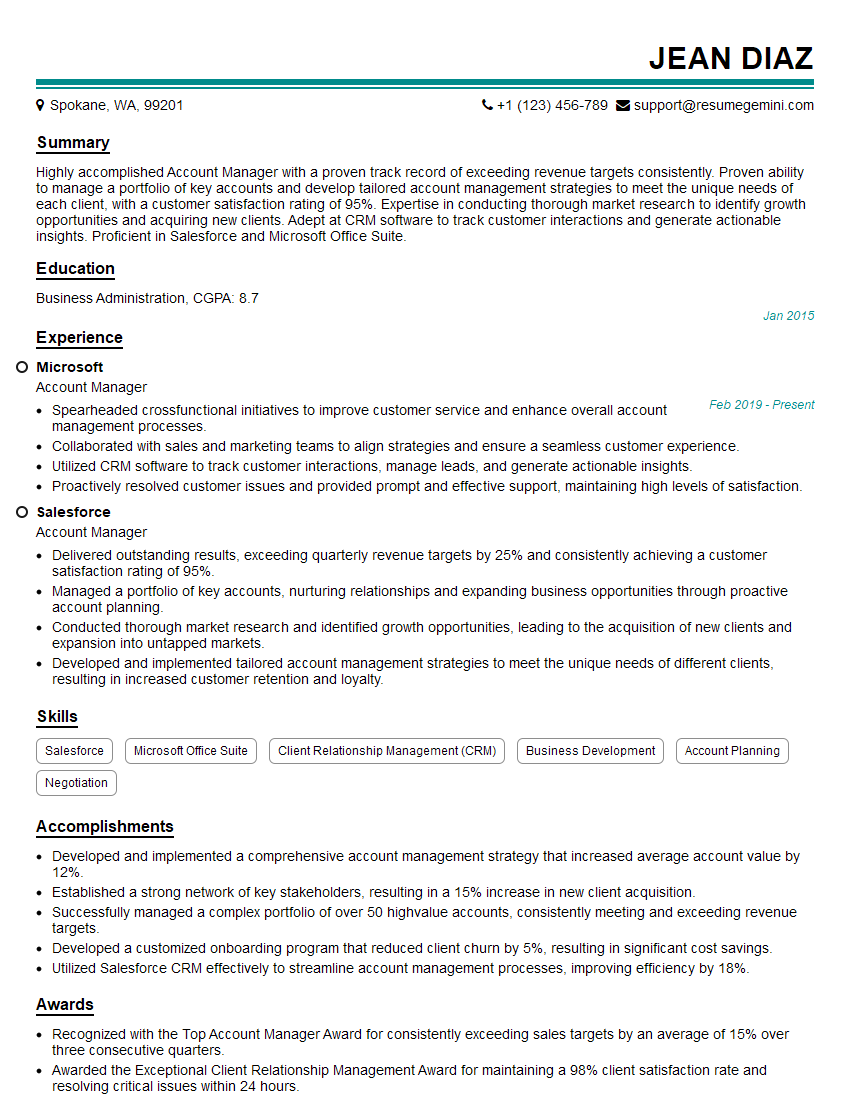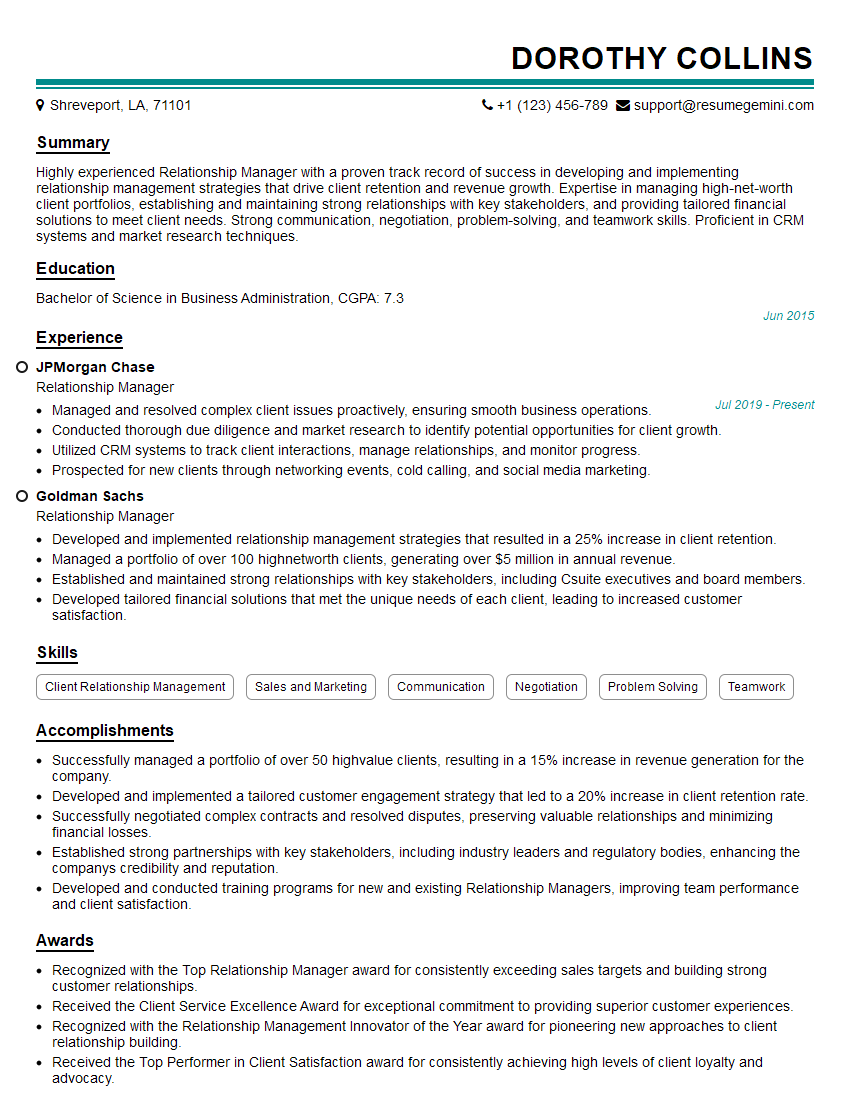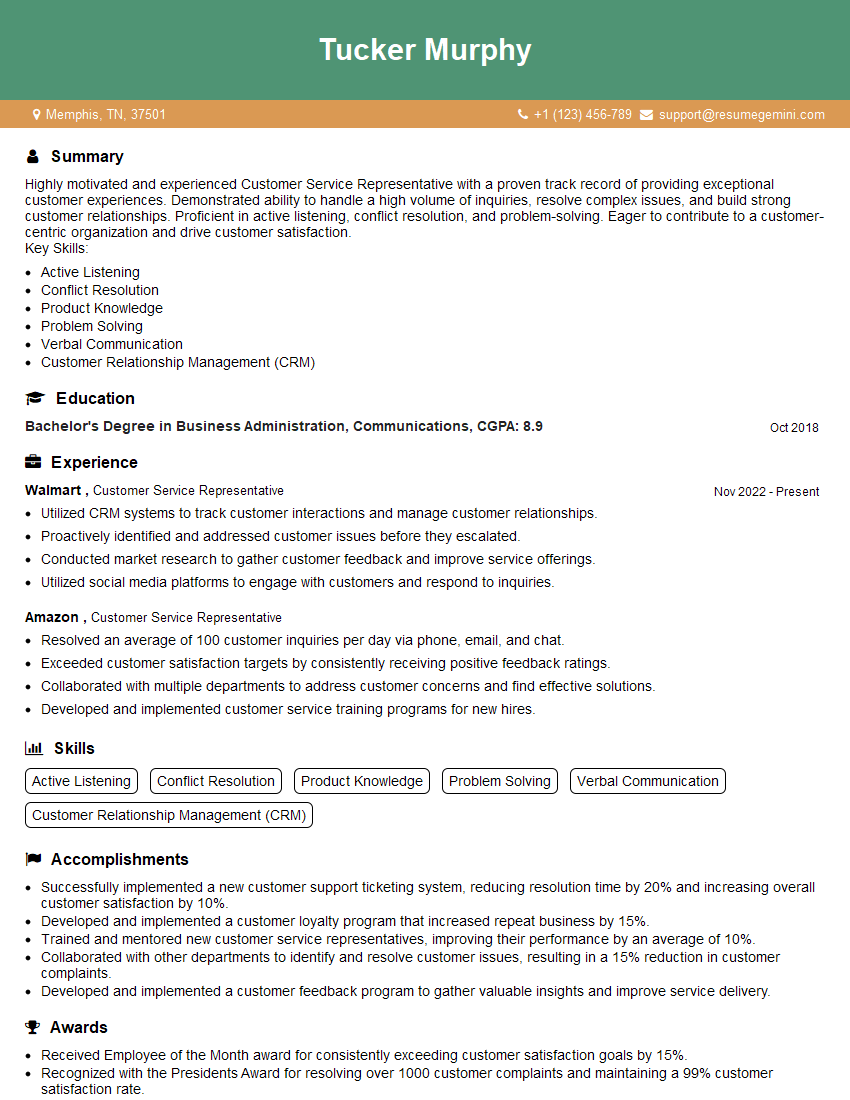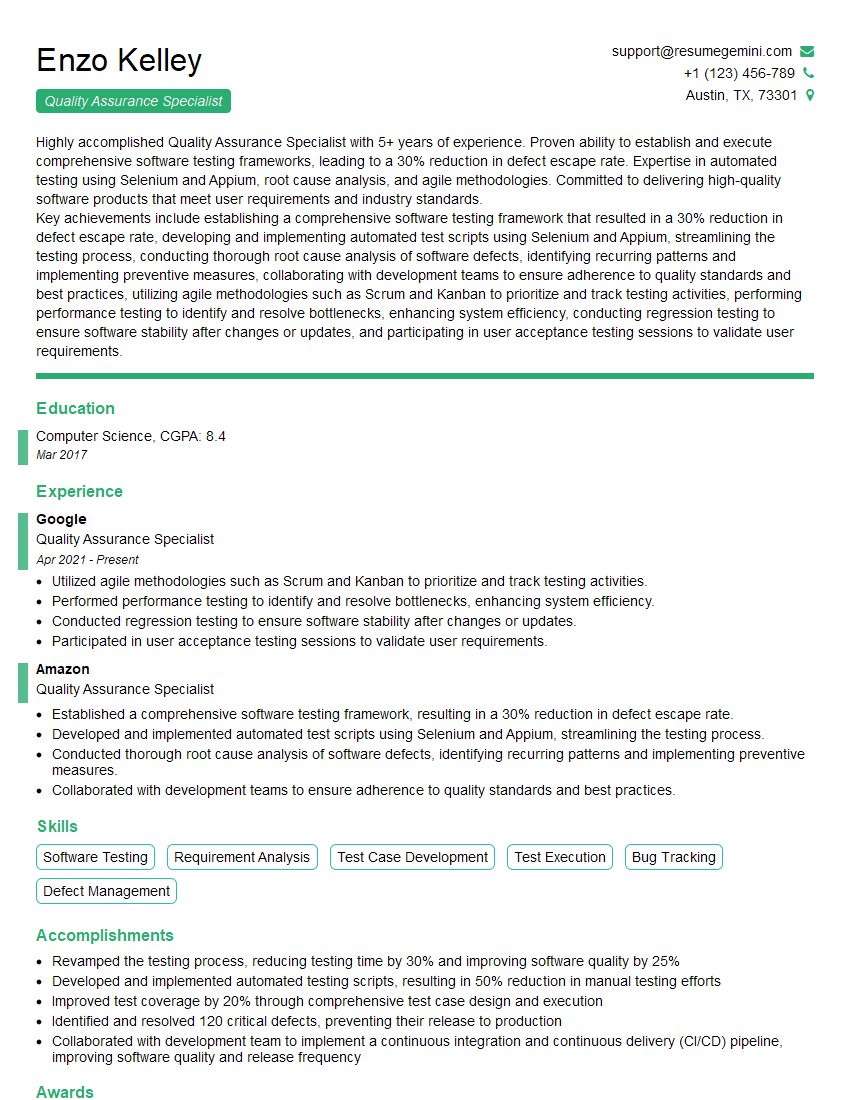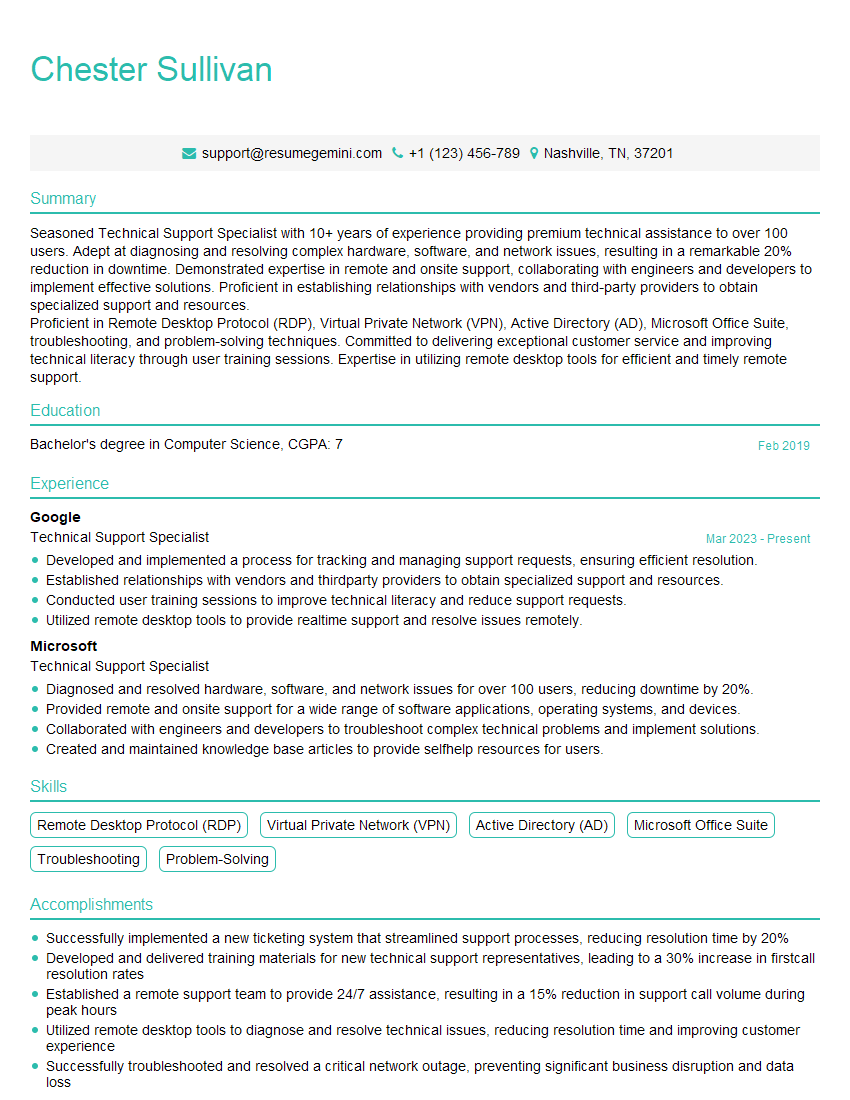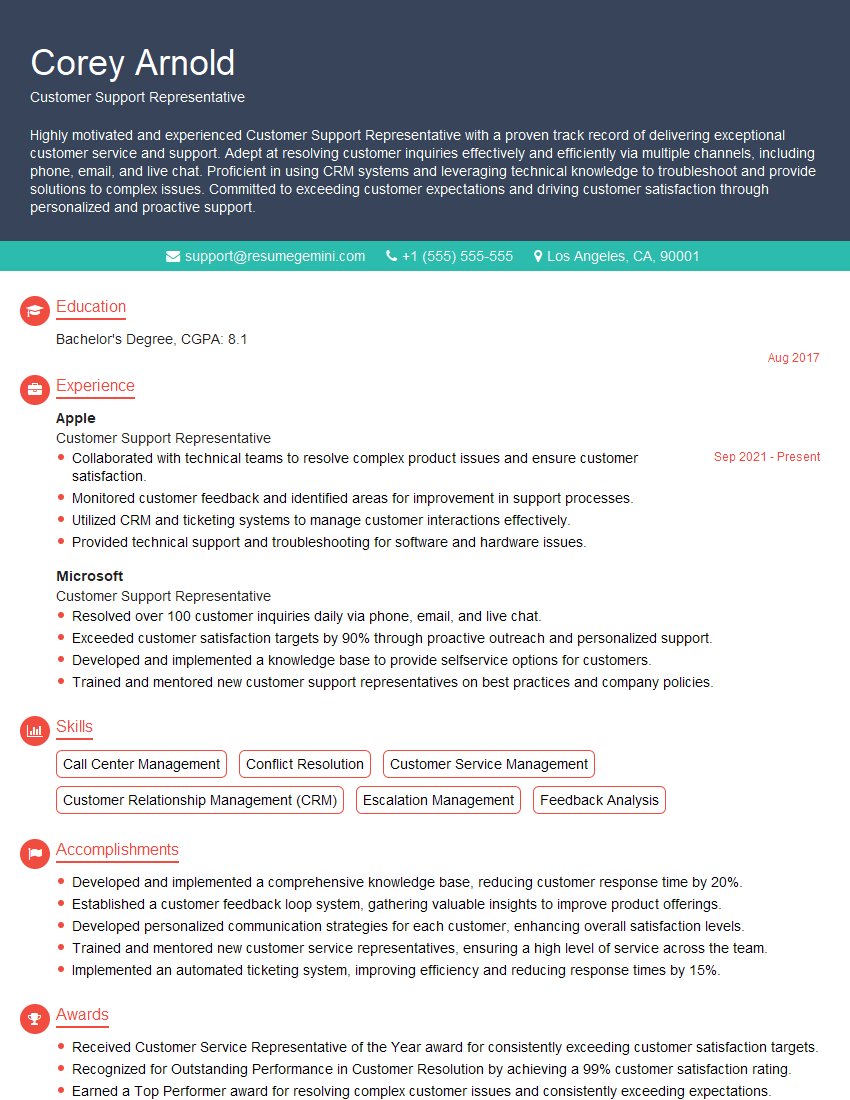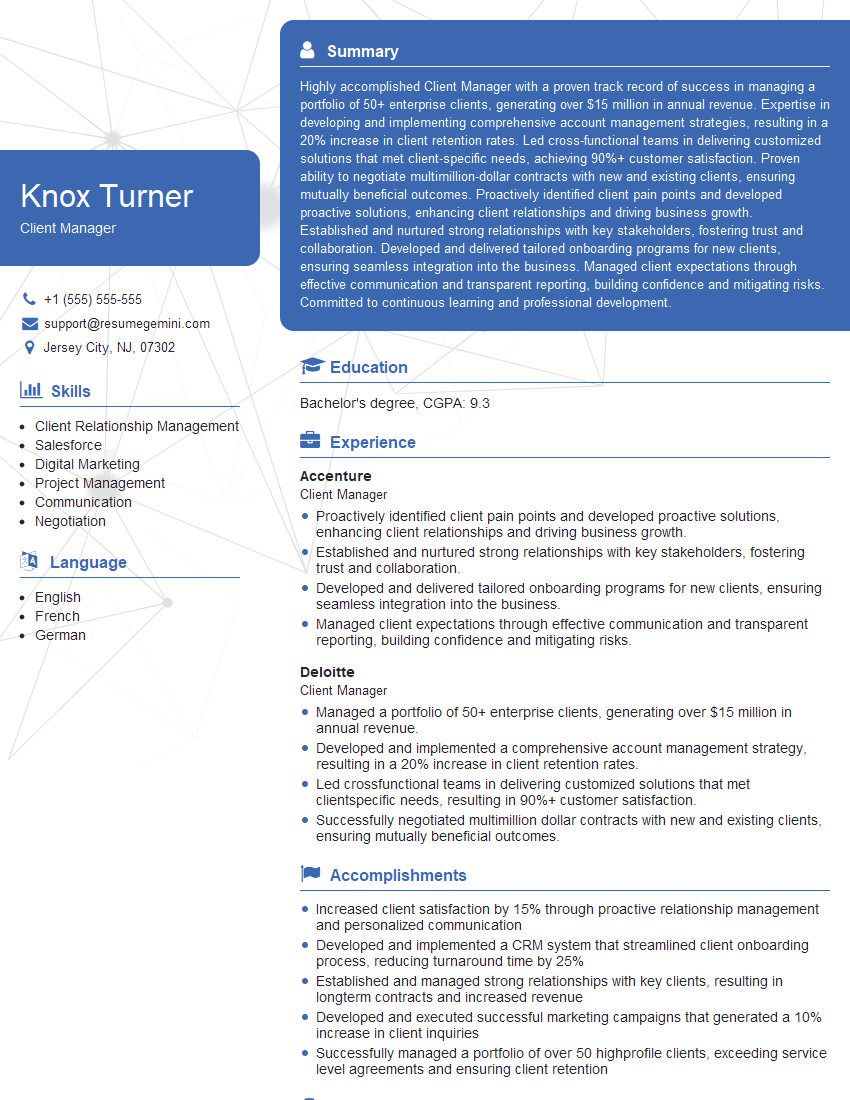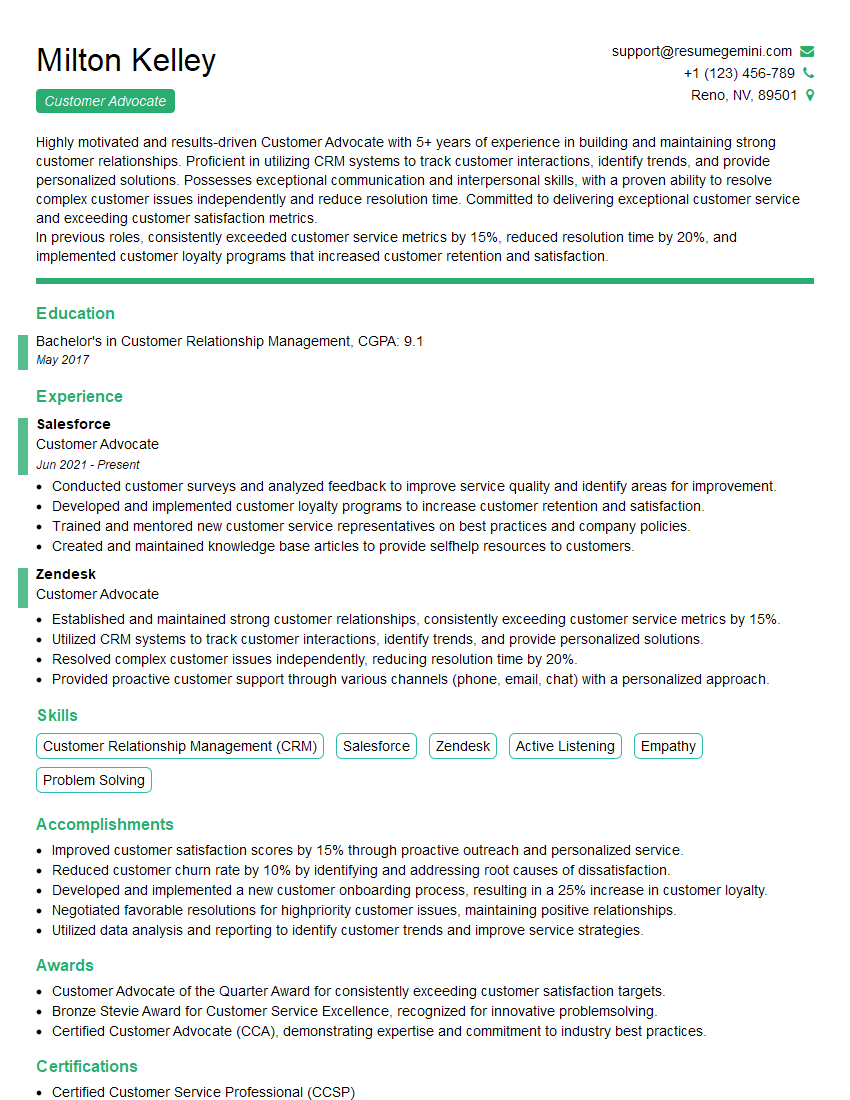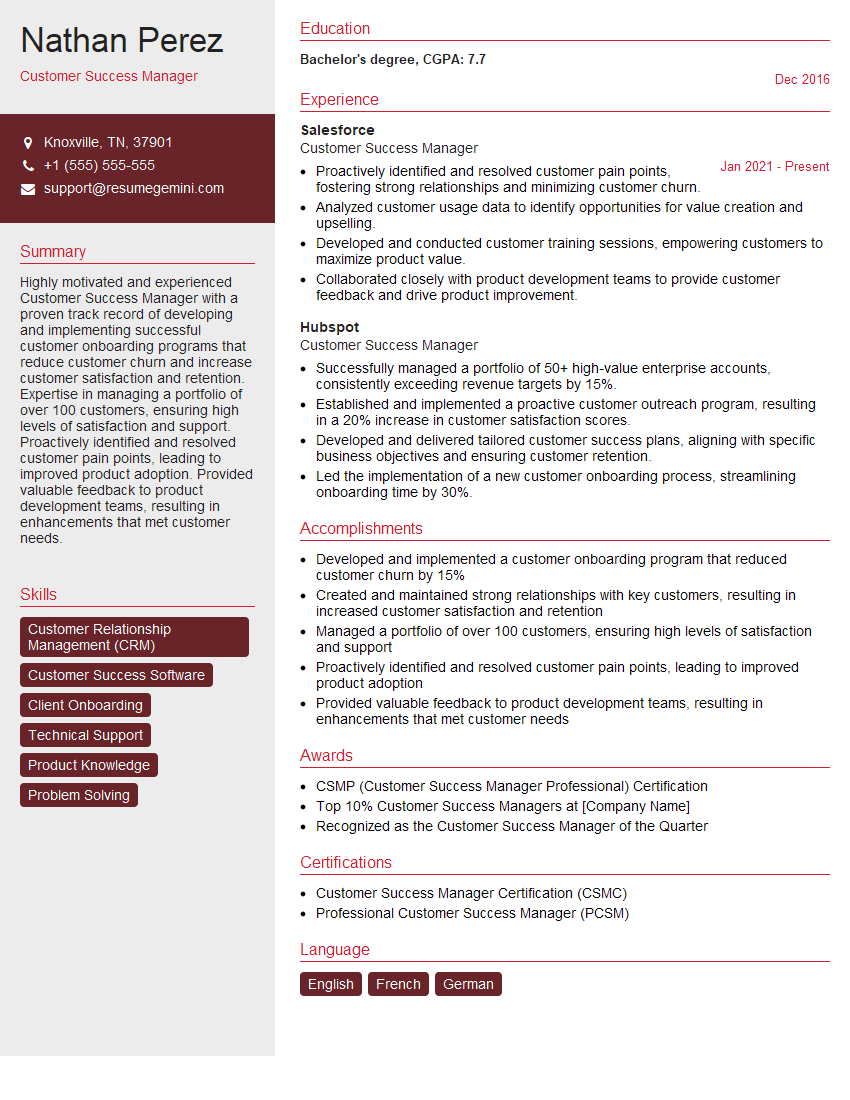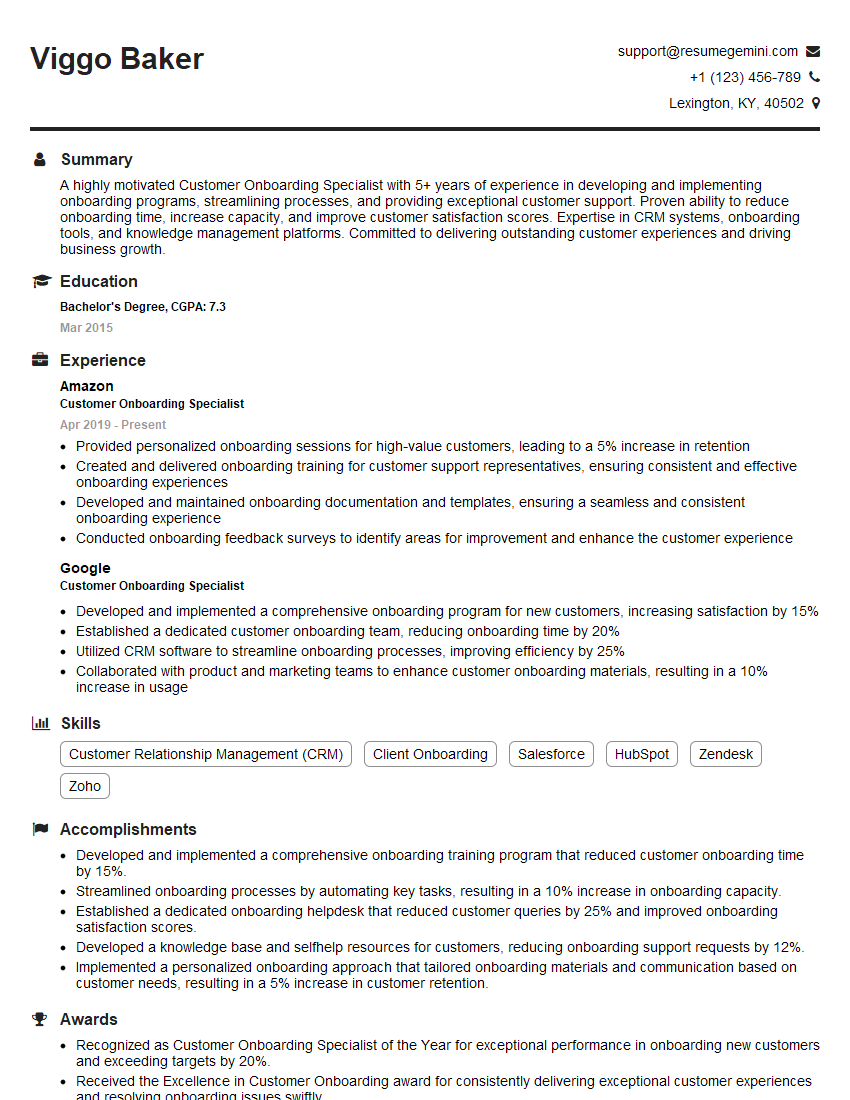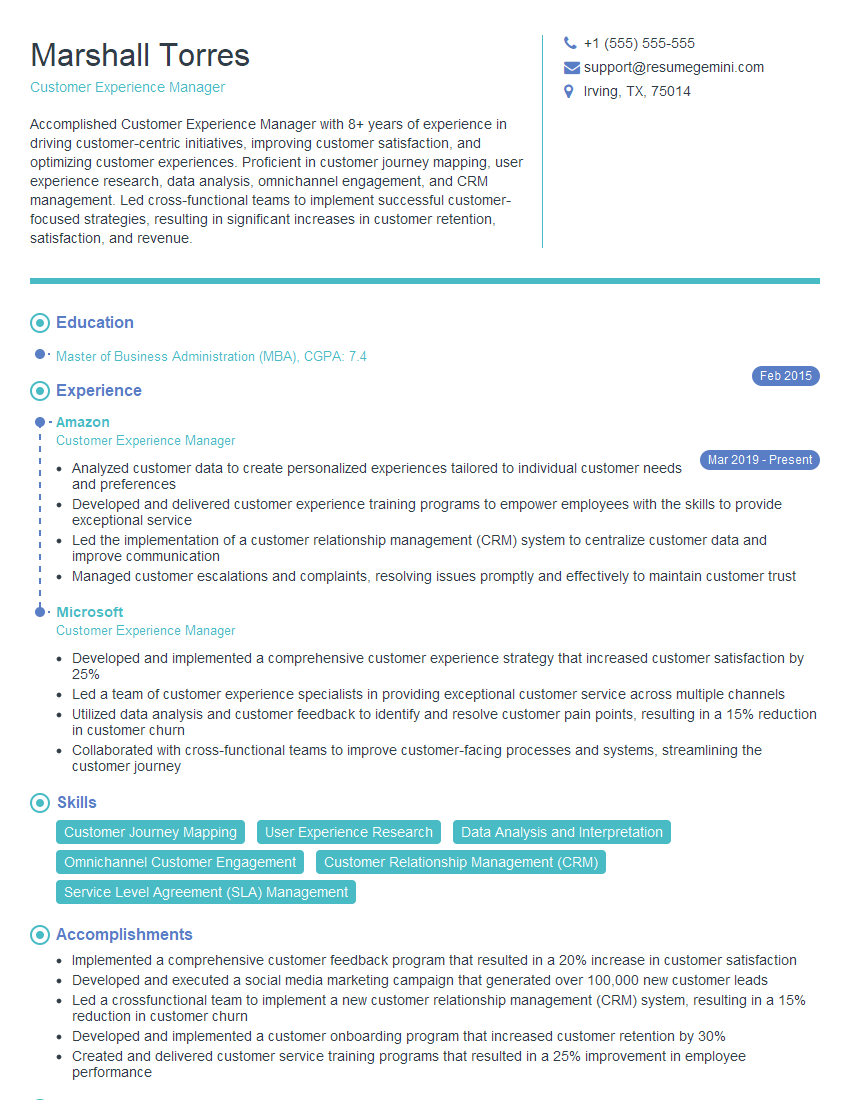Every successful interview starts with knowing what to expect. In this blog, we’ll take you through the top Customer Satisfaction Orientation interview questions, breaking them down with expert tips to help you deliver impactful answers. Step into your next interview fully prepared and ready to succeed.
Questions Asked in Customer Satisfaction Orientation Interview
Q 1. Describe your experience implementing customer satisfaction surveys.
Implementing customer satisfaction surveys is a crucial part of understanding your customer base and improving their experience. My approach involves a multi-stage process, beginning with clearly defining the survey’s objectives. What specific areas are we looking to improve? Are we assessing overall satisfaction, specific product features, or the customer service experience? This informs the type of questions included.
Next, I choose the appropriate survey method. Online surveys are often cost-effective and reach a broad audience, but phone or in-person surveys can offer richer qualitative data. The chosen method depends on the target audience and research goals. The survey itself needs to be concise, easy to understand, and visually appealing to ensure high completion rates.
After distributing the survey, I analyze the results using statistical methods to identify trends and patterns. I pay close attention to both quantitative data (e.g., rating scores) and qualitative data (e.g., open-ended feedback). Finally, I create a report summarizing the key findings and propose actionable recommendations for improvement. For example, if a survey reveals consistently low scores related to website navigation, we can prioritize improvements to the website’s user interface.
In a recent project, we used an online survey to assess customer satisfaction with a new software update. The analysis showed a surprising number of users struggling with a specific feature. This feedback led to the creation of a tutorial video and improved in-app guidance, resulting in a significant improvement in satisfaction scores in a subsequent survey.
Q 2. How do you measure customer satisfaction using key performance indicators (KPIs)?
Measuring customer satisfaction requires a balanced approach using various Key Performance Indicators (KPIs). These KPIs should be aligned with your overall business objectives and provide a comprehensive view of customer sentiment. Some essential KPIs include:
- Customer Satisfaction Score (CSAT): This measures how satisfied customers are with a specific interaction or product. It’s often measured on a scale (e.g., 1-5 or 1-10).
- Net Promoter Score (NPS): This gauges customer loyalty and willingness to recommend your product or service. It’s based on a single question: “On a scale of 0-10, how likely are you to recommend [company/product] to a friend or colleague?”
- Customer Effort Score (CES): This measures the ease with which customers can interact with your company and resolve their issues. A lower score indicates greater ease and higher satisfaction.
- Customer Churn Rate: This shows the percentage of customers who stop using your product or service over a given period. A high churn rate often indicates underlying customer satisfaction issues.
- Repeat Purchase Rate: This indicates customer loyalty and satisfaction. A higher rate suggests customers are happy with their experience and are likely to return.
Combining these KPIs gives a holistic view of customer satisfaction. For instance, a high CSAT but a low NPS could indicate customers are satisfied with individual interactions but not loyal enough to recommend the brand.
Q 3. Explain your approach to resolving customer complaints effectively.
Resolving customer complaints effectively requires empathy, efficiency, and a commitment to finding a fair resolution. My approach follows a structured process:
- Active Listening: First, I listen attentively to the customer’s complaint without interrupting, showing genuine empathy and understanding their frustration.
- Acknowledgement and Validation: I acknowledge their feelings and validate their concerns, even if I don’t fully agree with their perspective. A simple phrase like, “I understand your frustration,” can go a long way.
- Information Gathering: I gather all the necessary information to understand the situation thoroughly. This includes understanding the context of the issue, timeline, and any relevant documentation.
- Solution Proposal: Based on the gathered information, I propose a solution that addresses the customer’s concerns fairly and efficiently. This might involve a refund, replacement, repair, or other appropriate action.
- Follow-up: After implementing the solution, I follow up with the customer to ensure they are satisfied with the resolution and address any remaining concerns.
For instance, if a customer complains about a defective product, I would first empathize with their situation, gather evidence like order details and photos, offer a replacement or refund, and then follow up to ensure the replacement arrives without further issues.
Q 4. What techniques do you use to identify and address recurring customer issues?
Identifying and addressing recurring customer issues requires a systematic approach. I use a combination of techniques:
- Customer Feedback Analysis: Regularly reviewing customer surveys, feedback forms, and social media comments can reveal common complaints or pain points.
- Data Analytics: Analyzing customer support tickets, website usage data, and other relevant data can identify patterns and trends indicating recurring problems. For example, a high volume of support tickets related to a specific software feature suggests a potential usability issue.
- Customer Segmentation: Grouping customers based on shared characteristics can help identify specific segments experiencing recurring issues. This allows for targeted solutions.
- Root Cause Analysis: Once a recurring issue is identified, conducting a thorough root cause analysis helps determine the underlying causes and implement effective, long-term solutions.
For example, if we consistently receive complaints about long wait times for customer support, we can analyze call center data to identify bottlenecks and implement changes like hiring additional staff or improving call routing processes. Addressing the root cause is critical to preventing future recurrences.
Q 5. How would you prioritize competing customer requests?
Prioritizing competing customer requests requires a well-defined framework. I typically use a combination of factors:
- Urgency: Requests that require immediate attention, such as critical system failures or severe security breaches, take precedence.
- Impact: Requests with the greatest impact on the largest number of customers are prioritized higher. For example, a widespread software bug affecting many users would be prioritized over a minor issue affecting only a few.
- Business Value: Requests that align with business goals and strategic initiatives are given higher priority.
- Customer Segmentation: High-value customers or those with significant influence may receive prioritized attention.
I often use a prioritization matrix that visually represents these factors, allowing for a more objective and transparent decision-making process. This helps manage expectations and ensure that resources are allocated effectively to address the most critical requests first.
Q 6. Describe a time you improved customer satisfaction through a process change.
In a previous role, we noticed consistently low satisfaction scores related to order delivery times. Customers complained about lengthy processing times and inconsistent delivery dates. To improve this, we implemented a new warehouse management system that streamlined the order fulfillment process. We also partnered with a more reliable shipping carrier and implemented real-time order tracking.
The process change involved significant investment in new technology and training but resulted in a dramatic improvement in delivery times and customer satisfaction. Post-implementation surveys showed a significant increase in positive feedback related to delivery speed and reliability. This demonstrated the significant impact that process improvement can have on overall customer satisfaction.
Q 7. How do you handle difficult or angry customers?
Handling difficult or angry customers requires patience, empathy, and a de-escalation strategy. My approach is based on the following principles:
- Active Listening: Let the customer vent their frustration without interruption. Show that you’re listening attentively by using verbal and non-verbal cues.
- Empathy and Validation: Acknowledge their feelings and validate their concerns, even if you don’t agree with their perspective. Showing empathy builds trust and helps de-escalate the situation.
- Apology (When Appropriate): If the company is at fault, offer a sincere apology. This doesn’t necessarily mean admitting guilt but acknowledging their negative experience.
- Ownership and Control: Take ownership of the situation and demonstrate control by outlining the steps you’ll take to resolve the issue.
- Professionalism: Maintain a calm and professional demeanor throughout the interaction, even when faced with aggressive behavior.
- Seek Supervisor Support (If Needed): If you’re unable to resolve the issue independently, involve a supervisor to offer further support.
A key aspect is to remain calm and avoid getting defensive. The goal is to find a solution that satisfies the customer and prevents further escalation. Remember, a customer’s anger often stems from feeling unheard or unsupported. By addressing their concerns effectively, you can transform a negative experience into a positive one and enhance customer loyalty.
Q 8. What is your experience with customer relationship management (CRM) systems?
My experience with CRM systems is extensive. I’ve worked with various platforms, including Salesforce, HubSpot, and Zoho CRM, across different industries. I understand CRM not just as a database of customer contacts, but as a crucial tool for managing the entire customer lifecycle. This involves leveraging features such as contact management, lead nurturing, sales pipeline tracking, and customer service interactions. For example, in my previous role, we utilized Salesforce to track customer interactions, automate marketing campaigns, and analyze sales performance, ultimately leading to a 15% increase in conversion rates.
Beyond simply using the software, I have experience in configuring, customizing, and integrating CRM systems with other business tools, improving data accuracy and efficiency. I’m proficient in developing reports and dashboards to monitor key performance indicators (KPIs) related to customer engagement and satisfaction. This includes using CRM data to identify high-value customers and proactively address potential issues.
Q 9. How do you use customer feedback to improve products or services?
Customer feedback is the lifeblood of product and service improvement. I approach it systematically, using a combination of quantitative and qualitative methods. Quantitative feedback might include survey results (e.g., CSAT, CES scores) providing numerical data on customer satisfaction levels. Qualitative feedback, derived from customer reviews, interviews, and focus groups, reveals the ‘why’ behind the numbers. It allows us to understand the specific issues, pain points, and unmet needs.
For example, if a survey shows low satisfaction with a specific product feature, I would analyze qualitative data – comments, suggestions and complaints – to identify the root cause. This might reveal usability problems, bugs or unmet customer expectations. This understanding allows me to create actionable insights that can inform product development, design modifications, or customer service improvements.
It’s crucial to implement a closed-loop system, ensuring that customer feedback is not just collected but acted upon. Customers appreciate knowing their feedback has been heard and has resulted in positive change. This fosters trust and improves loyalty.
Q 10. How familiar are you with Net Promoter Score (NPS) and its implications?
The Net Promoter Score (NPS) is a key metric for measuring customer loyalty and predicting business growth. It’s based on a single question: “On a scale of 0 to 10, how likely are you to recommend [company/product/service] to a friend or colleague?”
Responses are categorized into Promoters (9-10), Passives (7-8), and Detractors (0-6). The NPS is calculated by subtracting the percentage of Detractors from the percentage of Promoters. A higher NPS indicates stronger customer loyalty and advocacy.
The implications of NPS are significant. It provides a benchmark for tracking customer satisfaction over time, identifying areas for improvement, and comparing performance against competitors. A low NPS might indicate underlying issues requiring attention, while a high NPS reflects a strong customer base likely to drive referrals and organic growth. Understanding the drivers behind NPS scores – both positive and negative – through follow-up questions or qualitative research is crucial for effective action.
Q 11. Describe your understanding of customer journey mapping.
Customer journey mapping is a visual representation of the steps a customer takes when interacting with a company or product. It encompasses all touchpoints, from initial awareness to post-purchase engagement. This includes things like website visits, social media interactions, customer service calls, and even word-of-mouth referrals.
By mapping the journey, we can identify pain points, areas of friction, and opportunities for improvement. A well-constructed map helps us understand the customer’s perspective, empathize with their needs, and optimize the entire experience. For example, a journey map might reveal a cumbersome checkout process or a lack of clear information leading to customer frustration. Addressing these issues can improve conversion rates, reduce customer churn, and enhance overall satisfaction.
A typical customer journey map includes elements like personas (representing customer segments), touchpoints, emotions at each stage, and potential areas for improvement.
Q 12. What strategies do you employ to foster customer loyalty?
Fostering customer loyalty requires a multi-faceted approach that goes beyond simply providing a good product or service. I employ strategies focusing on personalization, engagement, and building relationships.
- Personalized Experiences: Tailoring communications and offers based on customer preferences and behavior. This could involve segmented email campaigns, personalized product recommendations, or customized loyalty programs.
- Proactive Communication: Staying in touch with customers beyond transactional interactions. This includes regular newsletters, informative content, or simply checking in to see if they need assistance.
- Exceptional Customer Service: Providing quick, efficient, and empathetic support when issues arise. Empowering customer service representatives to resolve problems effectively is key.
- Loyalty Programs: Rewarding repeat customers with exclusive benefits, discounts, or early access to new products.
- Community Building: Creating a sense of community around the brand, perhaps through social media groups or exclusive events.
Ultimately, it’s about building lasting relationships based on trust, value, and mutual respect. Customers are more likely to remain loyal when they feel valued and appreciated.
Q 13. How do you balance customer needs with business objectives?
Balancing customer needs with business objectives is a crucial aspect of successful business strategy. It’s not a zero-sum game; rather, it’s about finding the sweet spot where both are met. This requires a deep understanding of both sides.
I approach this through data-driven decision-making. By analyzing customer feedback, market trends, and financial performance, we can identify opportunities to enhance the customer experience without compromising profitability. For example, we might invest in improving a specific product feature if data indicates it significantly impacts customer satisfaction and is linked to increased sales. Conversely, we might choose to prioritize cost-effective solutions if budget constraints are a factor.
Transparency is vital. Customers appreciate companies that are open about their challenges and limitations while demonstrating a commitment to meeting their needs within reasonable constraints. Open communication and clear expectations can go a long way in building understanding and trust.
Q 14. Explain your experience with customer segmentation and targeting.
Customer segmentation and targeting involve dividing a customer base into distinct groups based on shared characteristics, then tailoring marketing efforts to each segment. This allows for more effective and efficient resource allocation.
I have experience utilizing various segmentation methods, including demographic (age, location, gender), behavioral (purchase history, website activity), and psychographic (lifestyle, values, interests) segmentation. For example, a company might segment customers based on their purchase frequency to target high-value customers with exclusive offers or identify inactive customers for re-engagement campaigns.
Once segments are defined, targeted marketing strategies are developed. This could involve personalized email marketing, customized website content, or targeted advertising campaigns on social media platforms. The effectiveness of these strategies is closely monitored and adjusted as needed, ensuring that marketing efforts are optimized for maximum impact.
Q 15. Describe a situation where you had to make a difficult decision regarding customer service.
One challenging customer service situation involved a long-standing client whose project repeatedly faced delays due to unforeseen technical issues. The client, understandably, was extremely frustrated and threatened to terminate our contract. The decision I faced was whether to offer a significant discount to retain the client despite the project’s setbacks or stand firm on the original agreement. This involved weighing the potential loss of a valuable client against the financial implications of a discount.
My approach involved first empathizing with the client’s frustration, acknowledging the issues, and sincerely apologizing for the inconvenience. Then, I presented several options, including a revised project timeline with concrete deliverables, a partial discount, and an expedited problem-solving approach. Ultimately, we agreed on a partial discount coupled with a clear action plan for completing the project promptly and effectively. This compromise not only retained the client but also strengthened our relationship, demonstrating our commitment to their success.
Career Expert Tips:
- Ace those interviews! Prepare effectively by reviewing the Top 50 Most Common Interview Questions on ResumeGemini.
- Navigate your job search with confidence! Explore a wide range of Career Tips on ResumeGemini. Learn about common challenges and recommendations to overcome them.
- Craft the perfect resume! Master the Art of Resume Writing with ResumeGemini’s guide. Showcase your unique qualifications and achievements effectively.
- Don’t miss out on holiday savings! Build your dream resume with ResumeGemini’s ATS optimized templates.
Q 16. What is your approach to proactive customer communication?
Proactive customer communication is about anticipating needs and addressing potential issues *before* they become problems. It’s about building a relationship, not just reacting to issues. My approach involves several key strategies:
- Regular Check-ins: I schedule regular follow-up calls or emails to ensure clients are satisfied and address any emerging concerns.
- Personalized Communication: I tailor my communication to each client’s preferences and communication style.
- Educational Content: I proactively provide valuable information and resources, such as tutorials or FAQs, to help clients succeed.
- Early Problem Detection: I utilize monitoring tools and data analysis to identify potential issues early on. For instance, a sudden drop in user engagement might indicate a problem that needs immediate attention.
- Proactive Notifications: I provide timely updates on project progress, system maintenance, or important changes.
For example, if a client is using a software platform, I’d proactively send them a tutorial on new features, tips for optimization, or schedule a quick training session before they encounter issues. This approach helps prevent frustration and builds trust.
Q 17. How do you ensure consistent delivery of exceptional customer service?
Consistent delivery of exceptional customer service requires a multi-faceted approach. It’s not just about individual performance but also about creating a culture of customer centricity within the team.
- Standardized Processes: Implementing well-defined processes and service level agreements (SLAs) ensures consistent service across all interactions.
- Training and Development: Ongoing training programs equip the team with the skills and knowledge to handle various customer situations effectively. This includes training on empathy, problem-solving, and communication techniques.
- Performance Monitoring and Feedback: Regularly tracking key performance indicators (KPIs) such as customer satisfaction scores (CSAT), Net Promoter Score (NPS), and resolution times allows for identifying areas for improvement. Providing constructive feedback and coaching helps team members improve their performance.
- Empowerment and Autonomy: Empowering team members to make decisions within established guidelines enables them to efficiently address customer issues without constant supervision.
- Technology and Tools: Leveraging CRM systems and other customer service technologies helps streamline processes, improve response times, and track customer interactions.
For instance, creating a detailed customer service manual with standardized responses for common queries ensures all interactions follow a similar high standard. Regular team meetings reinforce best practices and encourage peer learning.
Q 18. How do you identify and address root causes of customer dissatisfaction?
Identifying and addressing root causes of customer dissatisfaction requires a systematic approach. It’s not enough to just address the immediate issue; we need to prevent it from happening again.
- Customer Feedback Analysis: Thoroughly analyzing customer surveys, reviews, and support tickets to identify recurring themes and patterns of complaints.
- Root Cause Analysis (RCA): Employing structured methods like the 5 Whys technique to delve into the underlying causes of problems. For example, if a customer complains about slow website loading times, asking ‘why’ repeatedly might reveal issues with server performance, inefficient coding, or inadequate bandwidth.
- Data Analysis: Using data analytics to identify trends and patterns in customer behavior, such as high churn rates or a spike in negative reviews. This helps pinpoint areas needing immediate attention.
- Process Improvement: Once root causes are identified, implementing process improvements to prevent similar issues in the future. This might involve updating software, refining workflows, or enhancing training materials.
- Customer Interviews: Conducting direct interviews with dissatisfied customers to gain a deeper understanding of their experience and concerns.
For example, if many customers complain about a confusing user interface, a root cause analysis might reveal insufficient user testing during the development phase. This could then lead to changes in the design and development processes, including more rigorous testing procedures.
Q 19. How do you track and report customer satisfaction metrics?
Tracking and reporting customer satisfaction metrics is crucial for understanding performance and identifying areas for improvement. I utilize a combination of quantitative and qualitative data.
- Quantitative Metrics: These include CSAT (Customer Satisfaction Score), NPS (Net Promoter Score), CES (Customer Effort Score), average handling time, first contact resolution rate, and customer churn rate. These metrics are typically tracked using CRM systems and survey tools.
- Qualitative Metrics: These are gathered through customer feedback surveys (open-ended questions), reviews, social media comments, and customer support interactions. Qualitative data provides richer insights into *why* customers are satisfied or dissatisfied.
- Reporting and Dashboards: I use data visualization tools to create dashboards that provide a clear and concise overview of key customer satisfaction metrics. This enables easy identification of trends and anomalies. Regular reports are shared with relevant stakeholders to inform decisions and drive improvements.
- Benchmarking: Comparing our performance against industry benchmarks helps identify areas where we excel and where we need to improve.
For instance, a dashboard could show the CSAT score over time, broken down by customer segment or product. Low CSAT scores in a specific area would trigger a deeper investigation using qualitative data to pinpoint the root causes.
Q 20. How do you contribute to a positive and supportive customer service team?
Contributing to a positive and supportive customer service team goes beyond individual performance. It involves fostering a collaborative and encouraging environment.
- Teamwork and Collaboration: Encouraging teamwork and knowledge sharing among colleagues. This can involve peer-to-peer mentoring and cross-training.
- Positive Reinforcement: Recognizing and rewarding team members for their achievements and contributions. Public acknowledgement of good work boosts morale and motivates others.
- Open Communication: Creating an open and honest communication environment where team members feel comfortable sharing ideas, concerns, and feedback. Regular team meetings are crucial.
- Conflict Resolution: Effectively addressing conflicts and disagreements among team members to maintain a harmonious work environment.
- Mentorship and Coaching: Providing support and guidance to less experienced team members. Mentorship helps build skills and confidence.
I strive to create an environment where everyone feels valued, respected, and empowered to provide exceptional customer service. This includes actively participating in team-building activities and providing constructive feedback to promote growth.
Q 21. What are your strengths and weaknesses in handling customer interactions?
My strengths in handling customer interactions include empathy, strong communication skills, and a proactive problem-solving approach. I excel at building rapport with customers, understanding their needs, and finding effective solutions. I am patient, even when dealing with difficult or demanding customers. I also pride myself on my ability to stay calm under pressure and maintain a positive attitude.
One area where I am continually working on is my time management skills, particularly when handling a high volume of inquiries simultaneously. I am actively developing strategies to prioritize tasks efficiently, utilizing tools and techniques to improve my workflow and reduce response times. This includes utilizing task management software and prioritizing urgent requests appropriately.
Q 22. What is your experience working with different customer communication channels?
Throughout my career, I’ve worked extensively across various customer communication channels, understanding that each platform demands a unique approach. I’m proficient in email, phone, live chat, social media (including platforms like Twitter, Facebook, and Instagram), and increasingly, messaging apps like WhatsApp. My experience involves not just responding to queries, but strategically choosing the best channel for a particular interaction. For instance, a complex technical issue might necessitate a phone call for immediate clarification and personalized assistance, whereas a simple order update is efficiently handled via email. Social media requires a different tone and often involves public responses, demanding careful consideration of brand image and reputation management. I’ve consistently tracked key performance indicators (KPIs) across all channels, including response times, resolution rates, and customer satisfaction scores, to optimize our communication strategies.
For example, in a previous role, we implemented a chatbot on our website to handle frequently asked questions. This significantly reduced the volume of incoming phone calls and emails, freeing up our agents to focus on more complex issues. We also analyzed social media mentions to identify emerging trends and proactively address potential problems before they escalated.
Q 23. Describe your understanding of customer lifecycle management.
Customer lifecycle management (CLM) is the holistic process of managing a customer’s journey from initial awareness to post-purchase engagement and beyond. It involves understanding customer needs at each stage, optimizing touchpoints, and building lasting relationships. I view CLM as a continuous loop, with each interaction providing valuable data to enhance future interactions. The stages typically include:
- Awareness: Attracting potential customers through marketing and branding.
- Acquisition: Converting leads into customers through sales and onboarding.
- Retention: Keeping customers engaged and loyal through excellent service and ongoing communication.
- Advocacy: Turning satisfied customers into brand ambassadors who recommend your product or service to others.
A practical example is a loyalty program that rewards repeat purchases and encourages engagement. Analyzing customer data throughout the lifecycle helps identify areas for improvement. For example, high churn rates during the retention phase might indicate a need for better customer support or product enhancements. I use CLM frameworks to guide marketing and support strategies, improving customer experience and driving business growth.
Q 24. How do you utilize customer data to personalize the customer experience?
Personalizing the customer experience relies heavily on leveraging customer data ethically and effectively. This involves collecting data responsibly, ensuring data privacy, and using it to tailor interactions to individual customer preferences. I utilize various data points, including purchase history, browsing behavior, demographics, and interaction history with customer service. This data allows for personalized recommendations, targeted marketing, and customized service interactions.
For instance, if a customer frequently purchases running shoes, we might send them emails about new running shoe releases or promotions. If a customer had a negative experience with a previous interaction, we might provide them with proactive support or a special offer to regain their trust. This personalized approach builds stronger customer relationships and fosters loyalty. However, I emphasize responsible data handling and transparency to maintain trust. Using segmentation and advanced analytics is key to effective personalization without intrusive practices.
Q 25. What is your approach to handling escalated customer issues?
My approach to escalated customer issues focuses on empathy, efficient problem-solving, and transparent communication. I begin by actively listening to the customer, validating their concerns, and expressing understanding. This establishes trust and de-escalates the situation. Next, I thoroughly investigate the issue, gather all necessary information, and identify the root cause. I then present a clear and concise solution, setting realistic expectations for resolution. During the process, I maintain transparent communication, keeping the customer informed every step of the way.
If the issue is beyond my immediate scope, I escalate it to the appropriate team, ensuring seamless handoff and continued communication with the customer. For example, I’ve used a problem-solving framework based on root cause analysis to pinpoint recurring issues and implement preventative measures. Following up with the customer after resolution ensures satisfaction and identifies areas for improvement in our processes.
Q 26. How do you train and mentor new customer service representatives?
Training and mentoring new customer service representatives is a crucial aspect of maintaining high service standards. My approach is multi-faceted, combining theoretical knowledge with practical application and ongoing support. Initial training covers product knowledge, communication skills, company policies, and the use of relevant tools and technologies. I use a mix of classroom-style lectures, interactive workshops, role-playing, and on-the-job shadowing. I also emphasize the importance of active listening, empathy, and problem-solving skills.
Mentoring involves ongoing support and guidance. I provide regular feedback, address concerns, and help representatives develop their skills. I also create opportunities for professional development through specialized training programs and external workshops. Measuring performance using key performance indicators (KPIs) and providing constructive feedback is essential to continuous improvement. Creating a supportive and collaborative environment is key to employee retention and high morale.
Q 27. What are your expectations of a customer-centric organization?
My expectations of a customer-centric organization are high. It should be a culture where the customer is at the heart of every decision. This means:
- Customer-focused culture: Employees at all levels are empowered to prioritize customer needs.
- Proactive problem-solving: Identifying and addressing customer issues before they escalate.
- Continuous improvement: Regularly seeking feedback and using it to improve processes and products.
- Data-driven decisions: Using customer data to inform strategies and personalize interactions.
- Empowered employees: Frontline staff have the authority to resolve customer issues efficiently.
- Transparent communication: Open and honest communication with customers, regardless of the issue.
In essence, a customer-centric organization should consistently strive to exceed customer expectations, building strong and lasting relationships.
Q 28. Describe your experience with implementing customer feedback management systems.
My experience with implementing customer feedback management systems encompasses the entire process, from selecting the right tools to analyzing data and using insights to drive improvements. I’ve worked with various systems, including survey platforms, social media monitoring tools, and customer relationship management (CRM) systems with built-in feedback mechanisms. The implementation process typically involves:
- Defining objectives: Clearly identifying what feedback is needed and how it will be used.
- Selecting appropriate tools: Choosing systems that align with the organization’s needs and budget.
- Designing surveys and feedback mechanisms: Creating clear, concise, and user-friendly surveys or feedback forms.
- Implementing and deploying: Integrating the chosen system with existing CRM or other relevant systems.
- Analyzing data and reporting: Regularly reviewing the feedback received, identifying trends, and generating reports.
- Action planning and implementation: Using feedback to inform decisions and make improvements.
For example, in a previous role, we implemented a Net Promoter Score (NPS) survey to measure customer loyalty. The insights gained from this survey allowed us to identify areas for improvement in our products and services, resulting in a significant increase in customer satisfaction and retention.
Key Topics to Learn for Customer Satisfaction Orientation Interview
- Understanding Customer Needs: Learn to identify and prioritize diverse customer needs and expectations across various touchpoints. This includes understanding both explicit and implicit needs.
- Active Listening and Empathy: Practice techniques for active listening and demonstrating empathy to build rapport and effectively address customer concerns. Consider how to effectively paraphrase and reflect customer emotions.
- Effective Communication Strategies: Master clear, concise, and professional communication, both verbally and in writing. Explore techniques for handling difficult conversations and resolving conflicts constructively.
- Proactive Problem Solving: Develop strategies for anticipating and proactively addressing potential customer issues before they escalate. This includes identifying common pain points and developing preventative measures.
- Performance Measurement and Improvement: Understand key metrics used to measure customer satisfaction (e.g., Net Promoter Score, Customer Effort Score) and how to analyze data to identify areas for improvement. Explore methods for implementing process changes based on data analysis.
- Customer Relationship Management (CRM) Systems: Familiarize yourself with common CRM systems and their role in managing customer interactions and data. Practice navigating and utilizing CRM tools for efficient customer service.
- Handling Difficult Customers and Complaints: Develop strategies for de-escalating tense situations, resolving complaints effectively, and turning negative experiences into positive ones. Consider different conflict resolution techniques.
- Teamwork and Collaboration: Understand the importance of teamwork in providing exceptional customer service. Explore techniques for collaborating effectively with colleagues to resolve customer issues.
Next Steps
Mastering Customer Satisfaction Orientation is crucial for career advancement in today’s competitive market. Demonstrating a strong understanding of these principles will significantly increase your job prospects and showcase your commitment to providing exceptional customer experiences. To further enhance your application, create an ATS-friendly resume that highlights your relevant skills and experiences. ResumeGemini is a trusted resource that can help you build a professional and impactful resume. We provide examples of resumes tailored to Customer Satisfaction Orientation to help you get started.
Explore more articles
Users Rating of Our Blogs
Share Your Experience
We value your feedback! Please rate our content and share your thoughts (optional).
What Readers Say About Our Blog
Hello,
We found issues with your domain’s email setup that may be sending your messages to spam or blocking them completely. InboxShield Mini shows you how to fix it in minutes — no tech skills required.
Scan your domain now for details: https://inboxshield-mini.com/
— Adam @ InboxShield Mini
Reply STOP to unsubscribe
Hi, are you owner of interviewgemini.com? What if I told you I could help you find extra time in your schedule, reconnect with leads you didn’t even realize you missed, and bring in more “I want to work with you” conversations, without increasing your ad spend or hiring a full-time employee?
All with a flexible, budget-friendly service that could easily pay for itself. Sounds good?
Would it be nice to jump on a quick 10-minute call so I can show you exactly how we make this work?
Best,
Hapei
Marketing Director
Hey, I know you’re the owner of interviewgemini.com. I’ll be quick.
Fundraising for your business is tough and time-consuming. We make it easier by guaranteeing two private investor meetings each month, for six months. No demos, no pitch events – just direct introductions to active investors matched to your startup.
If youR17;re raising, this could help you build real momentum. Want me to send more info?
Hi, I represent an SEO company that specialises in getting you AI citations and higher rankings on Google. I’d like to offer you a 100% free SEO audit for your website. Would you be interested?
Hi, I represent an SEO company that specialises in getting you AI citations and higher rankings on Google. I’d like to offer you a 100% free SEO audit for your website. Would you be interested?
good
